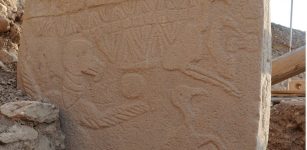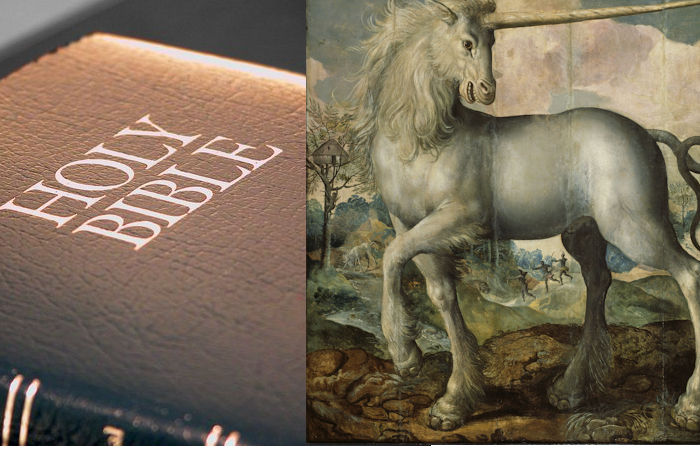The Unicorn In The Bible Was An Oryx – Ancient Translation Mistake
Ellen Lloyd - AncientPages.com - The unicorn is a legendary animal that has fascinated people for ages. Depictions of this magical and beautiful animal have been found on ancient seals, and early Greek writers believed the unicorn originated from India.
During the Middle Ages and Renaissance, people were incredibly interested in this mysterious creature no one had seen. As discussed in our previous article on Ancient Pages, Vikings used the opportunity and started selling faked unicorn horns and fooled Europeans with their bluff for hundreds of years.
Being in possession of a unicorn horn was everyone’s desire, but hardly possible due to the high price. It was believed that the alicorn, the horn itself, and the substance it was made of held magical and medicinal properties. Even the great painter Leonardo da Vinci was fascinated by the unicorn and wrote about it in his notebooks.
The Holy Bible. Credit: Kevin Probst - Public Domain - Unicorn by Maerten de Vos (1532–1603). Credit: Public Domain
Knowledge of the unicorn came from ancient Greek authors and the Bible, but no one knew the magical animal had been misidentified.
The Bible mentions the unicorn seven times, but only by mistake.
The mistake happened long before the birth of Christianity. The Old Testament was originally composed in Hebrew.
In 250 B.C., Ptolemy II Philadelphus, the second King of Egypt's Greek period, ordered 72 elders to translate the sacred Hebrew texts into Greek. That Greek translation is called the Septuagint. During the translation, the Jews encountered a problem. Their texts contained several references to an animal called "Re'em".
Re’em is the Hebrew name for oryx leucoryx or oryx, but the Jewish ancient scholars were confused by the descriptions in the Old Testament.
Left: Virgin Mary holding the unicorn (c. 1480), detail of the Annunciation with the Unicorn Polyptych, National Museum, Warsaw. Credit: Public Domain - Right: Maiden with Unicorn, tapestry, 15th century (Musée de Cluny, Paris). Credit: Public Domain
Modern Bible scholars believe that the Jewish texts are likely to refer to the two-horned oryx. Oryx leucoryx was once a lord of the entire Middle East. Its domain embraced most of the Land of Israel, but during the reign of King Ptolemy II Philadelphus, it had already been extinct in North Africa and the Middle East.
The original Jewish texts mention nothing about the animal having a horn, but the King's scribe chose, despite this, to call the animal monoceros, which can be translated into "a horn". The translation was continued when the Jewish texts became the Old Testament.
Unicorns still captivate modern people, and scientists have tried to find proof of their existence. Some years ago, a unicorn fossil was discovered in Siberia. The discovery caused a sensation. Scientists said unicorns were in fact real, but they looked slightly different from what we imagine today.
Written by Ellen Lloyd – AncientPages.com
Copyright © AncientPages.com All rights reserved. This material may not be published, broadcast, rewritten or redistributed in whole or part without the express written permission of AncientPages.com
More From Ancient Pages
-
 Riddle Of An Ancient Underground City No-One Thinks Exist – Symbol For A Spiritual Quest – Part 2
Ancient Mysteries | Sep 18, 2019
Riddle Of An Ancient Underground City No-One Thinks Exist – Symbol For A Spiritual Quest – Part 2
Ancient Mysteries | Sep 18, 2019 -
 1,700-Year-Old Vase For Olive Oil And Wine Unearthed At Historic Site Of Diyarbakir Fortress, Turkey
Archaeology | Aug 5, 2022
1,700-Year-Old Vase For Olive Oil And Wine Unearthed At Historic Site Of Diyarbakir Fortress, Turkey
Archaeology | Aug 5, 2022 -
 Michelangelo’s Hidden Secrets Under The Medici Chapel
Featured Stories | Jul 16, 2019
Michelangelo’s Hidden Secrets Under The Medici Chapel
Featured Stories | Jul 16, 2019 -
 More Than 1,000 Prehistoric Burial Mounds Discovered In The Netherlands
Archaeology | Jan 26, 2023
More Than 1,000 Prehistoric Burial Mounds Discovered In The Netherlands
Archaeology | Jan 26, 2023 -
 Oldest case of leukemia found on 7,000-Year-old skeleton
News | Aug 23, 2015
Oldest case of leukemia found on 7,000-Year-old skeleton
News | Aug 23, 2015 -
 Graves Of Celtic Princes Reveal How Powerful Women Were In Pre-Roman Germany
Archaeology | Jun 4, 2024
Graves Of Celtic Princes Reveal How Powerful Women Were In Pre-Roman Germany
Archaeology | Jun 4, 2024 -
 First Detailed Academic Study Of East African Maritime Traditions Shows Changes In Boatbuilding
Archaeology | May 11, 2022
First Detailed Academic Study Of East African Maritime Traditions Shows Changes In Boatbuilding
Archaeology | May 11, 2022 -
 What Happened To Mimbres People – Recently Examined Puzzle Gives Some Clues
Archaeology | Dec 29, 2021
What Happened To Mimbres People – Recently Examined Puzzle Gives Some Clues
Archaeology | Dec 29, 2021 -
 Researchers Sequenced 137 Human Genomes From The Middle East
Archaeology | Aug 6, 2021
Researchers Sequenced 137 Human Genomes From The Middle East
Archaeology | Aug 6, 2021 -
 Who Was The Sumerian Ensi?
Featured Stories | Jan 24, 2020
Who Was The Sumerian Ensi?
Featured Stories | Jan 24, 2020 -
 A Well-Preserved Lararium Shrine Discovered At Pompeii
Archaeology | Oct 10, 2018
A Well-Preserved Lararium Shrine Discovered At Pompeii
Archaeology | Oct 10, 2018 -
 History Shows: Taxes And Bureaucracy Are Cornerstones Of Democracy
Archaeology | Feb 18, 2021
History Shows: Taxes And Bureaucracy Are Cornerstones Of Democracy
Archaeology | Feb 18, 2021 -
 Why Did Winter Baths Become So Popular?
Ancient History Facts | Jan 16, 2024
Why Did Winter Baths Become So Popular?
Ancient History Facts | Jan 16, 2024 -
 A Ptolemaic Mummy Reveals Evidence Of Dental Filling Used In Ancient Egypt
Archaeology | Aug 6, 2020
A Ptolemaic Mummy Reveals Evidence Of Dental Filling Used In Ancient Egypt
Archaeology | Aug 6, 2020 -
 Unknown Ancient World Discovered Beneath East Antarctic Ice Sheet
Earth Changes | Oct 24, 2023
Unknown Ancient World Discovered Beneath East Antarctic Ice Sheet
Earth Changes | Oct 24, 2023 -
 Research Reveals A 3,500-Year History Of Dairy Consumption On The Tibetan Plateau
Archaeology | Apr 17, 2023
Research Reveals A 3,500-Year History Of Dairy Consumption On The Tibetan Plateau
Archaeology | Apr 17, 2023 -
 Frightening Edinburgh Vaults: The Spooky Underground City Of The Dead
Featured Stories | Jun 4, 2016
Frightening Edinburgh Vaults: The Spooky Underground City Of The Dead
Featured Stories | Jun 4, 2016 -
 Sir Christopher Wren – Genius Mind Of Most Influential British Architect Of All Time
Featured Stories | Feb 22, 2016
Sir Christopher Wren – Genius Mind Of Most Influential British Architect Of All Time
Featured Stories | Feb 22, 2016 -
 Unique Sword Casts New Light On Viking Voyages Across The North Sea
Archaeology | Jul 18, 2022
Unique Sword Casts New Light On Viking Voyages Across The North Sea
Archaeology | Jul 18, 2022 -
 Evidence Of Neolithic Bird Hunting In Upper Mesopotamia
Archaeology | Sep 27, 2023
Evidence Of Neolithic Bird Hunting In Upper Mesopotamia
Archaeology | Sep 27, 2023


